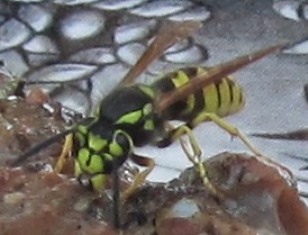An Unwelcome Visitor for Brunch
I welcome visits into my yard by honey bees–they are not interested in me or my plate of food (unless it has honey on it), but hornets, wasps, and yellow jackets are not welcome.
This past Sunday morning, I was enjoying a plate of food on my patio when a yellow jacket made an unwelcome appearance. These are the yellow and black predatory wasps you find on your soda cans and sweets at picnics. Some people call them “meat bees” but they are actually wasps.
What value are they to gardens, you might wonder. I did. Although I loathe them, I did a little research and discovered that yellow jackets are predators of insects that many of us gardeners consider pests. But try as I might, I just can’t make myself like yellow jackets. The females don’t just sting and die. They can sting multiple times. And wasp stings hurt.
About those stingers–they are like lances with barbs, injecting venom into you during a sting. The stings are not dangerous unless you happen to be stung repeatedly or you are allergic to bee and wasp stings. In that case, you might carry a epinephrine autoinjector (known as an EpiPen) in the event of a life-threatening sting to treat anaphylaxis.
Keep a lookout for yellow jackets in the spring when the queen seeks a place to construct a paper nest. These wasps (related to hornets) live in social colonies with female queens and workers, and also males, known as drones. They like to establish their nests in hollowed logs and human structures (like houses with holes for entry into attics or walls). They enjoy a diet rich in sugar and carbohydrates. Don’t we all? But take care when enjoying your al fresco Sunday brunch. You never know who might drop in!
Paper Wasps Under the Eaves
The small, yellow-striped paper wasps have built two nests under the eaves. These insects are considered agriculturally beneficial, but they tend to get a little too close for comfort. The nests are right above my front door.
The nests are open-cell structures held together by fibers that the queen has masticated from wood posts (and sometimes woody plant stems) and mixed with saliva to create the cells of the nest. The nest can be grow to six to eight inches across in order to accommodate a growing population.
Paper wasps feed their offspring caterpillars, beetle larvae, corn earworms, flies, tobacco hornworms, armyworms, and other insects.
These wasps can sting multiple times, unlike the gentle honeybee that can sting only once. Earlier this year, when we were working on our front windows and door, I was stung four times on my cheek. For people allergic to bee stings, the sting can be life-threatening. It’s recommended to wear a bee suit when removing the nest as the wasps will attack in response to the threat to their nest.
The best time to remove the nest is evening when the wasps are less active and on the nest. High pressure water can be used to knock down the nest. I wrapped a hand towel saturated with a strongly scented kitchen cleaner. I took the nests down and then quickly went back into the house. The next day, a random paper wasp was back, apparently ready to rebuild. What was I to do, but reapply the smelling kitchen cleaner. The wasps are gone now.
 Facebook
Facebook Goodreads
Goodreads LinkedIn
LinkedIn Meera Lester
Meera Lester Twitter
Twitter




